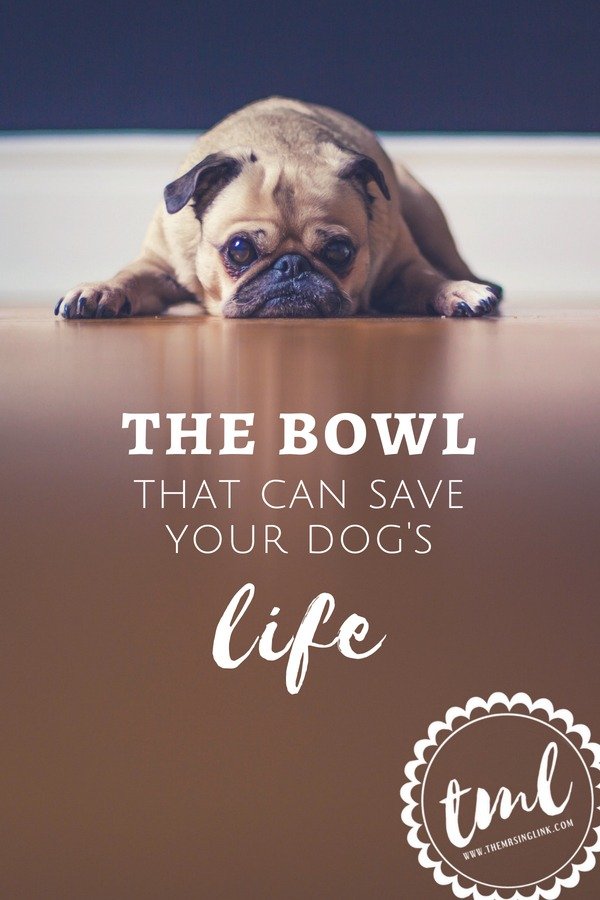Don’t call me crazy, yet.
So for just shy of 10 years, I worked at an animal hospital. If you asked – I’ve seen my fair share of everything in terms of animal life and pet care. But one of the very few things that has really stuck with me over those years, was the one thing that can do life-threatening harm to your dog by simply the way they eat.
Or, eating too quickly.
What happens that is so life-threatening? Well, dogs who eat too quickly are likely to have what is called Gastic Dilatation Volvulus, or more simply called “Bloat“. If you’ve never heard this before, and you have a dog that eats too quickly – then this information pertains to you.
*This post contains affiliate links. If you purchase through these links, I will receive a teeny weeny commission!*
the bowl that can
save your dog’s life
What exactly is “bloat“?
Bloat occurs when the dog’s stomach is quickly filled with gas, food or fluid – causing the dog’s stomach to expand (which is not a good thing).
This builds pressure on other organs, leading to:
- No blood flow to heart and stomach lining
- A tear in the wall of the stomach
- Difficulty breathing in your pet
In some cases, the dog’s stomach will “twist”, like when you wring the water out of a wash cloth, which is then why it is called Gastic Dilatation Volvulus, because this causes a kink in the stomach that traps blood flow to the heart and other areas of the body.
This is what will send your pet into shock.
What are the signs?
While the symptoms are very subtle in the beginning, which is why most say bloat is hardly recognizable. But when it occurs, it comes very quickly on once your pet has eaten.
If bloat is not quickly acknowledged and treated by a vet, it can be fatal. Treatment could cost as much as thousands of dollars, especially if your pet will need to undergo immediate surgery in order to “untwist” the stomach. I’ve seen a number of pets require that surgery, and let me tell you – it’s not a pretty aftermath, nor a pretty penny.
The signs you can look for in your pet for bloat are (up to an hour after eating):
- Restlessness/Anxious activity
- Drooling/foaming at the mouth
- Your pet may continuously look at their stomach (they will look in that direction due to inflicted pain or discomfort)
- Swelling of the stomach
- Your pet may try to vomit, but nothing comes up (very important!)
- Pacing/Laying down for a long period/Lethargy
Vets aren’t 100% on what causes bloat, but the main risk factors are:
- Pets eating from a RAISED food bowl
- Having only 1 large meal a day
- Eating too quickly (Your pet is likely inhaling more air into the stomach this way)
- Vigorous activity prior or right after eating
- Eating and/or drinking too much
What breeds are most at risk?
All breeds can be at this risk. But there does seem to be an increased risk in the breeds of dogs that have deep, broad, protruding chests, such as:
- Labradors
- Dobermans
- Boxers
- Greyhounds
- Rottweilers
- Basset Hounds
- Great Danes
- St. Benards
- German Shepherds
- Weimaraners
But even in some cases bloat has occurred in smaller breed dogs just the same, such as with:
- Dachshunds
- Italian Greyhounds
- Bulldogs
- French Bulldogs
How fast is too fast?
I was asked this a lot. And honestly – think about when you inhale your food. I’ll bet you don’t feel too good after most of the time, right? Your body goes into overdrive just to digest your food, and it actually doesn’t digest your food properly. So, by how fast – you be the judge. If your large dog can finish 2 cups of food in under 60 seconds, that’s too fast. If your small dog can finish 1/2 cup of food in under 30-45 seconds, that’s too fast.
So unless your dog nibbles, leaves the bowl, comes back 15 minutes later to nibble some more – taking nearly all day to finish 1 meal – then I’d say you’re fine. Or if you notice your dog eats kibble by kibble, and makes chewing sounds throughout the process of eating – then I’d say you’re safe.
Regardless, your perception of slow might not be what your dog’s body can actually handle.
Connect with me on Twitter, Instagram & Facebook so you don’t miss the latest blog updates!
Get your dog a “fast-eater bowl“
I have two dogs – one 50 pound Catahoula/Lab mix, and a 20 pound Mini Australian and Papillon mix breed. The lab mix inhales his food, while my smaller dog eats kibble by kibble. So, I bought a fast-eater bowl for my larger dog (pictured below).
These bowls are not much more – if at all – than regular dog bowls from the pet store. Plus, they’re a fun, interactive way to slow your pet down while eating and give them mental stimulation when eating their meals. Win, win!
Please do you and your dog a huge favor, even if you don’t think they eat too quickly, by purchasing one of these bowls. Give yourself peace of mind when you leave your dog’s food bowl out before leaving for work, or if you feed them before turning to bed. The last thing you want to know is that you could have saved your dog’s life by simply slowing down their eating habits.
If your dog has ever experienced bloat, then you should have been explained everything from your vet, and if you would like to share your experience for others fe free to do so.
